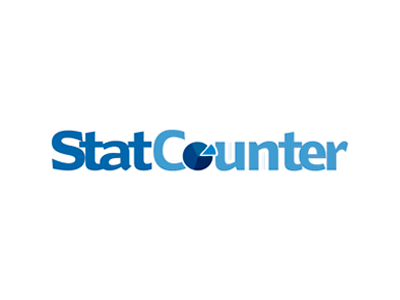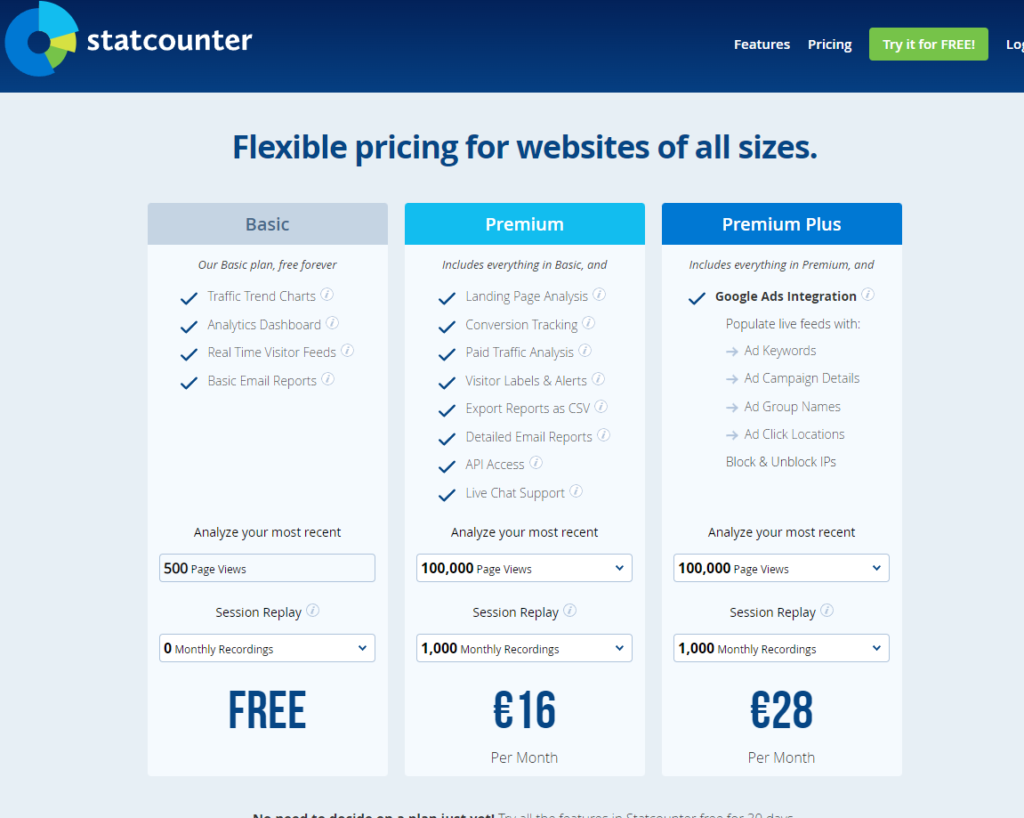In the bustling digital ecosystem, the tools we choose to navigate the vast sea of data can either be our compass or our anchor. As businesses of all sizes seek to understand their online presence and optimize user experience, the question isn’t just about having data—it’s about making sense of it. Enter the arena two formidable contenders in the world of analytics: Statcounter and Heap. Both platforms offer unique strengths, but how do they stack up when it comes to user-friendliness and ease of use? This comparison seeks to unravel that mystery, guiding you to the analytics tool that not only fits your needs but also aligns seamlessly with your workflow.
Statcounter | Heap |
|---|---|
| G2 Score – 4.3 out of 5 stars | G2 Score – 4.4 out of 5 stars |
| TrustRadius Score – 9/10 | TrustRadius Score – 8.2/10 |
User-Friendly Interface and Ease of Use
At the heart of any analytics tool is its interface—the bridge between raw data and actionable insights. A user-friendly interface not only simplifies data analysis but also empowers users to make informed decisions swiftly. Let’s dive into how Statcounter and Heap approach this critical aspect.
Statcounter: Simplicity as a Virtue
Statcounter has long been appreciated for its straightforward approach to analytics. Designed with clarity in mind, its dashboard and reporting tools are intuitive, making it accessible for users regardless of their technical prowess. This simplicity is Statcounter’s hallmark, ensuring that small to medium-sized businesses can track their website’s performance without getting bogged down in complexity. From real-time data to visitor tracking, Statcounter provides the essentials with minimal fuss, embodying the principle that sometimes, less is indeed more.
Heap: Sophistication Meets User-Centric Design
Heap takes a different route, offering a rich feature set that caters to businesses looking for in-depth user behavior insights. Despite its sophisticated analytics capabilities, Heap manages to maintain a user-friendly interface. It achieves this by employing a clean design and logical navigation that guide users through complex data sets and analytics functions with ease. Heap’s interface is built with the user in mind, ensuring that even the most advanced analyses are accessible to those who may not have a background in data science.
Depth of Analytics and Insight
In the digital age, the depth of analytics and the insights a tool provides can significantly impact strategic decisions. Businesses often require more than just surface-level data; they need in-depth analysis that can drive growth and improve user experience. This is where the distinction between Statcounter and Heap becomes particularly pronounced.
Statcounter: Essential Insights for Immediate Decisions
Statcounter focuses on delivering essential analytics that cater to immediate decision-making needs. It excels in providing real-time data, visitor tracking, and basic behavior analysis, which are invaluable for small to medium-sized enterprises (SMEs) looking to monitor their website’s performance efficiently. Statcounter’s strength lies in its ability to offer clear, concise insights without overwhelming users with excessive data. This approach is particularly beneficial for businesses that require straightforward analytics to guide their web presence and marketing strategies.
Heap: Comprehensive Data for Strategic Analysis
Heap takes analytics a step further by offering comprehensive data collection and analysis capabilities. It automatically captures every user interaction on your website or product, from clicks and form submissions to page views and beyond. This exhaustive data collection enables businesses to conduct detailed analysis and uncover insights into user behavior, funnel conversion, and customer journey mapping. Heap’s analytics provide the depth needed for businesses to make strategic decisions based on user interactions, helping to identify opportunities for optimization and growth.
Data Ownership and Portability
In a digital environment where data is a key asset, understanding how analytics platforms handle data ownership and the flexibility they offer for data export and use outside the platform is vital for businesses planning for long-term growth and data utilization. The ability to maintain control over your data and to move it freely across different platforms and services is crucial for businesses that rely on data to inform their strategies and decisions. Data ownership pertains to the rights a business has over the data collected through its operations, while data portability refers to the ease with which this data can be exported, shared, or utilized across different systems.
Statcounter: Clarity in Data Ownership with Basic Export Options
Statcounter provides clear terms regarding data ownership, ensuring that businesses retain control over the data generated from their websites. This approach reinforces trust and transparency, critical components for businesses in managing their online analytics. When it comes to data portability, Statcounter offers basic export options, allowing businesses to download reports and data for use outside the platform. While sufficient for small to medium-sized businesses with relatively straightforward analytics needs, companies requiring extensive data manipulation and integration with other systems may find these capabilities somewhat limited.
Heap: Comprehensive Data Management with Enhanced Portability
Heap emphasizes comprehensive data management practices, including robust data ownership policies and advanced options for data portability. Recognizing the importance of data as a strategic asset, Heap provides businesses with the tools needed to export detailed datasets for analysis beyond the platform’s native capabilities. This flexibility is particularly valuable for businesses that leverage data across multiple platforms, enabling richer insights and greater agility in data-driven decision-making. Heap’s approach to data ownership and portability is designed to meet the needs of businesses focused on in-depth analytics and who may require sophisticated data integration with other tools and systems.

Related: Check out our free SEO suite

Integration and Ecosystem Compatibility
As businesses increasingly rely on a diverse array of software and platforms for their operations, the ability of an analytics tool to integrate seamlessly within this ecosystem becomes crucial. This integration enhances data synergy, streamlines workflows, and ultimately, drives more informed decision-making. The landscape of digital tools a business uses can range from content management systems and email marketing platforms to CRM software and social media analytics. A robust analytics tool should ideally integrate smoothly with these tools, pulling in data from various sources to provide a holistic view of the business’s online presence and customer interactions.
Statcounter: Focused on Web Analytics Integration
Statcounter’s primary integration capability revolves around its seamless incorporation into websites through a simple code snippet. This ease of integration ensures that Statcounter can begin tracking website data almost immediately across various platforms. While its direct integrations with other business tools may be limited, Statcounter’s strength lies in its ability to provide valuable, straightforward web analytics without complicating the user experience with extensive setup processes. This makes it an attractive option for businesses seeking to enhance their web analytics without the need for broad ecosystem compatibility.
Heap: Versatile Integration for Comprehensive Insights
Heap stands out for its versatile integration capabilities with a wide range of platforms and tools. It’s designed to operate within a complex digital ecosystem, providing businesses with the ability to track user interactions across different platforms and tools seamlessly. From integrating with CRM software to syncing with marketing automation platforms, Heap’s flexibility in integration allows businesses to consolidate data across various touchpoints. This comprehensive approach not only simplifies data management but also enriches the insights available to businesses, enabling more nuanced analysis and strategy development.
Customer Support and Learning Resources
The level and quality of support provided by an analytics platform can greatly influence user satisfaction and the overall effectiveness of the tool. As users navigate the complexities of data analysis, accessible support and comprehensive learning resources become invaluable aids in leveraging the full potential of an analytics tool. Both Statcounter and Heap offer various forms of customer support and resources aimed at helping users maximize their use of the platforms. However, the approach and breadth of these offerings can differ, impacting how users interact with and derive value from each tool.
Statcounter: Direct and Efficient Support
Statcounter is known for its efficient and accessible customer support, designed to quickly address the needs of its users. Offering a mix of comprehensive FAQs, detailed documentation, and direct email support, Statcounter ensures that users can find answers to their questions with minimal effort. This level of support is particularly beneficial for small businesses or individuals who may not have extensive technical expertise but still wish to make informed decisions based on their web analytics. While Statcounter’s community might not be as large or as active as some other platforms, the direct support provided is targeted and effective, making it a reliable option for users seeking straightforward analytics solutions.
Heap: Rich Educational Resources and Community Engagement
Heap differentiates itself with a strong emphasis on educational resources and community engagement. Beyond offering direct customer support, Heap provides users with an extensive knowledge base, including tutorials, webinars, and case studies that cover a wide range of topics from basic setup to advanced analytics techniques. Furthermore, Heap encourages community engagement through forums and user groups, fostering a collaborative environment where users can share insights, ask questions, and learn from each other’s experiences. This approach not only enhances the user experience but also empowers businesses to delve deeper into their data, uncovering insights that can drive strategic decisions.
Pricing Structures and Cost-Effectiveness
In the competitive world of digital analytics, understanding the investment required and the return on that investment is crucial for businesses making informed decisions about which tools to adopt. The cost of implementing an analytics solution can vary significantly between platforms, influenced by factors such as the depth of analytics offered, the scale of operations, and additional features like integration capabilities and support services. A clear understanding of each platform’s pricing structure, alongside the value it provides, can help businesses align their choice with their budget and analytical needs.
Statcounter: Straightforward and Affordable

Statcounter is known for its straightforward pricing model, which includes a free version for basic usage and several paid tiers that scale with a website’s traffic and the level of detail required in the analytics. This model makes Statcounter an attractive option for small to medium-sized businesses or individual website owners who need essential web analytics without a significant financial commitment. The cost-effectiveness of Statcounter lies in its simplicity and the immediate value it provides through essential web traffic insights, making it a practical choice for those with straightforward analytics needs.
Heap: Value-Driven Pricing for Comprehensive Analytics

Heap’s pricing model reflects its comprehensive approach to analytics, offering plans that cater to businesses of different sizes and at various stages of growth. While the starting cost may be higher than some basic analytics platforms, Heap’s value proposition is rooted in the depth and breadth of insights it provides. Its ability to capture detailed user interactions and generate actionable insights for optimizing user experience and conversion rates justifies its pricing for businesses looking to invest in advanced analytics. Heap also offers custom enterprise solutions, ensuring that larger organizations or those with specific requirements can tailor the platform to their needs.
Conclusion
Concluding the comparison between Statcounter and Heap, it’s clear that each platform serves distinct needs within the analytics landscape, catering to different audiences based on their specific requirements for web and user behavior analytics.
Statcounter stands out for its simplicity and accessibility, making it an ideal choice for small to medium-sized businesses or those just embarking on their digital journey. Its straightforward approach to web analytics, focusing on essential metrics and visitor behavior, provides immediate value without overwhelming users with complexity. Statcounter’s clear data ownership policies and basic export options cater to businesses seeking simple, effective tools to monitor and enhance their online presence.
Heap, on the other hand, offers a comprehensive solution for businesses aiming to dive deeper into their analytics. With its advanced event tracking, detailed user behavior analysis, and flexible data management features, Heap is particularly suited for medium to large enterprises or those with complex digital products. Its emphasis on comprehensive data integration, sophisticated data portability, and a strong commitment to data ownership makes Heap a powerful tool for companies looking to leverage analytics for strategic decision-making and to gain a competitive edge in their market.
Read Next:
- GetResponse vs Zoho Campaigns: The Best Email Marketing Tool for 2024
- AWeber vs ActiveCampaign: The Best Email Marketing Tool
- Constant Contact vs Campaigner: Best Email Marketing Tool
- GetResponse vs Omnisend: The Best Email Marketing Tool for 2024
- AWeber vs Benchmark Email: The Best Email Marketing Tool






















Comments are closed.